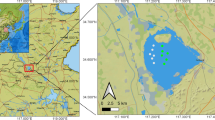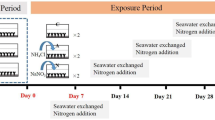Abstract
Seagrass meadows have seriously deteriorated in recent years. Seagrass associated phytate-mineralizing rhizobacteria potentially have functions related to seagrass nutrition, health and sustainable growth. The β-propeller phytases (BPPs) are the only phytase family in aquatic environments, but there are few studies on the BPP community structure of seagrass. In this study, clone libraries and quantitative PCR (qPCR) assays were used to compare the diversity and abundances of the BPP communities of Halodule endl, Halophila ovalis and Thalassia hemprichii in Xisha and Sanya, and to investigate the distribution characteristics of BPP genes in the rhizosphere sediment, which provedes insight into species specialty from phytic mineralization in subtropical and tropical seagrass ecosystems. The highest diversity of BPP genes was found for Thalassia hemprichii in Sanya Bay. Thalassia hemprichii in Sanya had higher abundances of BPPs, which were linked to Gammaproteobacteria. The BPP community diversity and OTUs of Thalassia hemprichii in Sanya were much higher than those of Thalassia hemprichii on Yongxing Island and Stone Island. The seagrass BPP communities had higher diversity and evenness from sampling sites with more human activity. The qPCR results showed that the abundance of phytate acid-degradating bacteria was approximately three times larger in Thalassia hemprichii rhizosphere sediment samples than in Halodule endl and Halophila ovalis rhizosphere sediment samples. This study highlighted that the diversity and abundances of bacteria genetically encoding BPP in the rhizosphere of Thalassia hemprichii were clearly higher than those of Halodule endl and Halophila ovalis. Further study of microbial phosphorus cycling will provide new insights into seagrass meadow ecosystems.





Similar content being viewed by others
References
Adav SS, Chen MY, Lee DJ, Ren NQ (2007) Degradation of phenol by acinetobacter strain isolated from aerobic granules. Chemosphere 67(8):1566–1572
Alias N, Shunmugam OPY (2018) Isolation and molecular characterization of phytase producing bacteria from malaysia hot springs. J Fundam Appl Sci 9(2):852–865
Bourque AS, Vega-Thurber R, Fourqurean JW (2015) Microbial community structure and dynamics in restored subtropical seagrass sediments. Aquat Microb Ecol 74(1):43–57
Cheng C, Lim BL (2006) Beta-propeller phytases in the aquatic environment. Arch Microbiol 185(1):1–13
Cho JS, Lee CW, Kang SH, Lee JC, Bok JD, Moon YS, Choi YJ et al. (2003) Purification and characterization of a phytase from Pseudomonas syringae MOK1. Curr Microbiol 47(4):0290–0294
Cordell D, Drangert JO, White S (2009) The story of phosphorus: global food security and food for thought. Glob Environ Change 19(2):292–305
Cotta SR, Cavalcante Franco Dias A, Seldin L, Andreote FD, Van Elsas JD (2016) The diversity and abundance of phytase genes (β-propeller phytases) in bacterial communities of the maize rhizosphere. Lett Appl Microbiol 62(3):264–268
Crosby CH, Bailey JV (2012) The role of microbes in the formation of modern and ancient phosphatic mineral deposits. Front Microbiol 3(241):6
Dennison WC, Orth RJ, Moore KA, Stevenson JC, Carter V, Kollar S, Batiuk RA et al. (1993) Assessing water quality with submersed aquatic vegetation: habitat requirements as barometers of Chesapeake Bay health. BioScience 43(2):86–94
Duffy JE (2006) Biodiversity and the functioning of seagrass ecosystems. Mar Ecol Prog Ser 311:233–250
Ghosh U, Subhashini P, Dilipan E et al. (2012) Isolation and characterization of phosphate-solubilizing bacteria from seagrass rhizosphere soil. J Ocean Univ China 11(1):86–92
Henry M, Begley M, Neve H et al. (2010) Cloning and expression of a mureinolytic enzyme from the mycobacteriophage TM4. Fems Microbiol Lett 311(2):126–132
Huang H, Shi P, Wang Y et al. (2009) Diversity of beta-propeller phytase genes in the intestinal contents of grass carp provides insight into the release of major phosphorus from phytate in nature. Appl Environ Microbiol 75(6):1508–1516
Irving GCJ, Cosgrove DJ (1971) Inositol phosphate phosphatases of microbiological origin, some properties of a partially purified bacterial (Pseudomonas sp.) phytase. Aust J Biol Sci 24(3):547–558
Jorquera MA, Crowley DE, Marschner P, Greiner R, Fernández MT, Romero D, De La Luz Mora M et al. (2011) Identification of β-propeller phytase-encoding genes in culturable Paenibacillus and Bacillus spp. from the rhizosphere of pasture plants on volcanic soils. FEMS Microbiol Ecol 75(1):163–172
Kim OH, Kim YO, Shim JH, Jung YS, Jung WJ, Choi WC, Kim H et al. (2010) β-Propeller phytase hydrolyzes insoluble Ca2+-phytate salts and completely abrogates the ability of phytate to chelate metal ions. Biochemistry 49(47):10216–10227
Kim OH, Kim YO, Shim JH, Jung YS, Jung WJ, Choi WC, Lee H, Lee SJ, Kim KK, Auh JH, Kim H, Kim JW, Oh TK, Oh BC (2010) β-propeller phytase hydrolyzes insoluble Ca(2+)-phytate salts and completely abrogates the ability of phytate to chelate metal ions. Biochemistry 49(47):10216
Kuang WQ, Li J, Zhang S, Long LJ (2015) Diversity and distribution of Actinobacteria associated with reef coral Porites lutea. Front Microbiol 6:1094–1094
Kuhar K, Kansal R, Mishra A, Koundal KR, Gupta VK (2012) Cloning, characterization and expression analysis of a novel gene encoding Kunitz-type protease inhibitor from Dolichos biflorus. 3 Biotech 2(3):199–209
Lim BL, Yeung P, Cheng C, Hill JE (2007) Distribution and diversity of phytate-mineralizing bacteria. ISME J 1(4):321–330
Lung SC, Chan WL, Yip W, Wang L, Yeung EC, Lim BL (2005) Secretion of beta-propeller phytase from tobacco and Arabidopsis roots enhances phosphorus utilization. Plant Sci 169(2):341–349
Maltais-Landry G, Scow K, Brennan E (2014) Soil phosphorus mobilization in the rhizosphere of cover crops has little effect on phosphorus cycling in California agricultural soils. Soil Biol Biochem 78:255–262
Maougal RT, Brauman A, Plassard C, Abadie J, Djekoun AD (2014) Bacterial capacities to mineralize phytate increase in the rhizosphere of nodulated common bean (phaseolus vulgaris) under p deficiency. Eur J Soil Biol 62:8–14
Mukhametzyanova AD, Akhmetova AI, Sharipova MR (2012) Microorganisms as phytase producers. Microbiology 81(3):267–275
Park I, Cho J (2011) The phytase from antarctic bacterial isolate, Pseudomonas sp. JPK1 as a potential tool for animal agriculture to reduce manure phosphorus excretion. Afr J Agric Res 6(6):1398–1406
Ramesh A, Sharma SK, Joshi OP, Khan IR (2011) Phytase, phosphatase activity and p-nutrition of soybean as influenced by inoculation of bacillus. Indian J Microbiol 51(1):94–99
Sahoo S, Biswas D, Datta S, Choudhury RB (2009) Studies on degradation of diesel and other petroleum fractions by Acinetobacter junii, cta3. Bioences Biotechnol Res Asia 6(1):169–174
Schloss PD, Westcott SL, Ryabin T et al. (2009) Introducing mothur: open-source, platform-independent, community-supported software for describing and comparing microbial communities. Appl Environ Microbiol 75(23):7537–7541
Shen L, Wu XQ, Zeng QW, Liu HB (2016) Regulation of soluble phosphate on the ability of phytate mineralization and β-propeller phytase gene expression of Pseudomonas fluorescens jz-dz1, a phytate-mineralizing rhizobacterium. Curr Microbiol 73(6):1–9
Singh B, Boukhris I, Pragya KV, Alghamdi OA (2020) Contribution of microbial phytases to the improvement of plant growth and nutrition: a review. Pedosphere 30:295–313
Stout LM, Nguyen TT, Jaisi DP (2016) Relationship of Phytate, Phytate-Mineralizing Bacteria, and Beta-Propeller Phytase Genes along a Coastal Tributary to the Chesapeake Bay. Soil Sci Soc Am J 80(1):84–96
Van Cappellen P, Ingall ED (1994) Benthic phosphorus regeneration, net primary production, and ocean anoxia: A model of the coupled marine biogeochemical cycles of carbon and phosphorus. Paleoceanography 9(5):677–692
Wan W, Qin Y, Wu H, Zuo W, He D (2020) Isolation and characterization of phosphorus solubilizing bacteria with multiple phosphorus sources utilizing capability and their potential for lead immobilization in soil. Front Microbiol 11:752
Zhang W, Shan B, Li J, Tang W, Jin X, Zhang H, Zhu X (2015) Characteristics, distribution and ecological risk assessment of phosphorus in surface sediments from different ecosystems in Eastern China: a 31P-nuclear magnetic resonance study. Ecol Eng 75:264–271
Acknowledgements
The research was supported by Strategic Priority Research Program of the Chinese Academy of Sciences (XDA13020300), Key Special Project for Introduced Talents Team of Southern Marine Science and Engineering Guangdong Laboratory (Guangzhou) (GML2019ZD0402), National Key Research and Development Program of China (2017YFC0506301, 2018YFC1406501, 2018FY100105), the National Natural Science Foundation of China (41676163, 41406191, 41676107, 41276114), Guangdong Province Public Welfare Research and Capacity Building Project (2015A020216016), Science and Technology Planning Project of Guangdong Province, China (2017B030314052), and Pearl River S&T Nova Program of Guangzhou (201806010017), Innovation Academy of South China Sea Ecology and Environmental Engineering, Chinese Academy of Sciences (ISEE2018ZD02), Guangdong Provincial Department of Education, China (2014KQNCX195). We thank all of the members of the tropical Marine Biological Research station and Research Station in Hainan and Daya Bay and Xisha/Nansha Ocean Observation for their work in the field sample collection.
Author information
Authors and Affiliations
Corresponding authors
Ethics declarations
Conflict of interest
The authors declare no competing interests.
Ethical approval
This article does not contain any studies with human participants or animals performed by any of the authors.
Additional information
Publisher’s note Springer Nature remains neutral with regard to jurisdictional claims in published maps and institutional affiliations.
Rights and permissions
About this article
Cite this article
Lin, L., Ling, J., Peng, Q. et al. The distribution characteristics of β-propeller phytase genes in rhizosphere sediment provide insight into species specialty from phytic mineralization in subtropical and tropical seagrass ecosystems. Ecotoxicology 30, 1781–1788 (2021). https://doi.org/10.1007/s10646-021-02425-2
Accepted:
Published:
Issue Date:
DOI: https://doi.org/10.1007/s10646-021-02425-2




